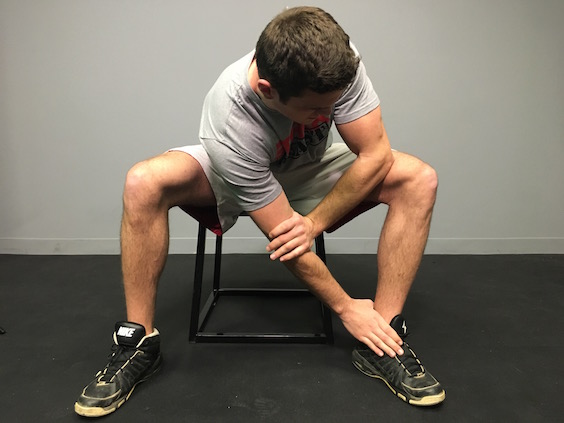Why Staring at Your Phone is Ruining Your Spine
![]()
How much do you check your phone every day? Do you frequently surf the web, check social media and text your friends?
If you’re like most people, your answer is YES, A LOT.
According to a study from Nottingham Trent University, the average person checks his or her phone 85 times per day and spends a total of five hours using the device—over 20 percent of the day.
We get it. Smartphones are incredible, and it’s difficult to take your eyes off your phone, especially if you have some downtime.
But be warned. Having your eyes glued to your phone for hours every day could be totally screwing up your neck, and it could cause long-term health issues if you’re not careful.
What is Text Neck?
According to Spine-Health.org, “text neck” refers to neck pain or other issues caused by looking down at your phone, tablet, computer, smart watch and other devices too frequently throughout the day.
Your neck is technically called the cervical spine. Seven vertebrae are tasked with supporting your head, protecting your spinal cord and allowing for 360 degrees of movement. It has more mobility than all other parts of the spine.
When you look down at your phone, your cervical spine moves into what’s called flexion. It’s designed to handle this movement, but problems occur when you spend too much time in this position.
In a Washington Post article, Dr. Ken Hansraj, chief of spine surgery at New York Spine Surgery and Rehabilitation Medicine, explains that the weight placed on your cervical spine dramatically increases when your head tilts forward—as shown below:
- 0 degrees – 10-12 pounds
- 15 degrees – 27 pounds
- 30 degrees – 40 pounds
- 45 degrees – 49 pounds
- 60 degrees – 60 pounds
Can you imagine your neck supporting 60 pounds of weight? This seems absurd. You would (hopefully) never place 60 pounds on your neck for fear of injury. But that’s the potential stress you put on your neck each time you check your phone.
Again, looking down from time to time is not a problem. But you might be putting your neck in a position it’s not meant to maintain for a significant amount of time and duration.
The result is your body begins to adapt to this position, similar to how your hips adapt to sitting for too long.
RELATED: How to Fix Anterior Pelvic Tilt
According to the Text Neck Institute, this position eventually leads to a number of health problems, including:
- Flattening of the spinal curve
- Early onset arthritis
- Disc herniation and compression
- Muscle and nerve damage
The result is neck pain, shoulder and upper back pain and even numbness and tingling in the face, shoulder and arm. Eventually, you may need to regularly see a physical therapist and/or a chiropractor, and you may even require surgery to fix the most severe problems.
Not good!
According to Paul Gagne, a posturologist who trains several NHL players, this forward posture affects the rest of the body, and can impair sports performance.
“Always staring down creates a tremendous amount of tension in the cervical spine, and also the upper back, and it will create a rounding of the shoulders,” he says. “If you stay like this for too long, you will be seizing up. If you go to the gym and play sports, your body is pre-exhausted from daily activity.”
The resulting posture makes it difficult for pitchers, tennis players and quarterbacks to get their arm overhead in the proper position without something else compensating, probably the lower back. It even can lead to tight hip flexors, which screw up your sprinting stride and exercise technique, among other issues.
Even your eyes are affected, Gagne says. Eye receptors that help keep you balanced turn off and eye muscles weaken, which limits eye performance—particularly your peripheral vision.
Put simply, if there’s a problem in your body, other areas will be impaired or have to compensate to pick up the slack.
How to Fix Text Neck
Fixing text neck is a bit tricky, mostly because we spend so much time looking down.
There are some corrective exercises you can perform regularly to reverse or prevent some of the symptoms:
Chin Packs

Chin Packs activate the cervical extensor muscles on the back of your neck, which helps to counterbalance overactive muscles on the front of your neck.
How to: Give yourself a double chin and hold this position for one or two seconds. Release and repeat. To keep your neck in proper alignment, place your index finger on your chin and thumb on your sternum. Your chin should touch your index finger between each rep.
Sets/Reps: 1-2×10
Bat Wing Rows

Strength and conditioning expert Dan John recommends Bat Wing Rows to activate the rhomboids and reset your posture. These muscles sit on neck-to-spine and help move the shoulder blades. They are often ignored during traditional back workouts.
How to: Lie with your stomach on a bench and hold dumbbells in each hand with your arms straight below your shoulders. Drive your arms back and pull the dumbbells to your sides. Squeeze your shoulder blades together for one count at the top of the movement.
Sets/Reps: 4×5
90/90 Pec Stretch

This stretch helps to loosen tight chest muscles that pull you into a forward rounded posture.
How to: Assume a staggered stance with a door frame or squat rack post to your right. Bend your elbow to 90 degrees and place your forearm on the frame or rack. Your upper arm should be parallel to the ground. Lean forward until you feel a stretch in your pec.
Sets/Duration: 1×1 minute each side
Additionally, you should regularly include neck strength exercises in your workouts to build a strong and durable neck.
Performing these exercises should help you feel better, but they won’t completely solve the problem.
“Unless you stretch for 10 hours a day, you need to modify your behavior or you will be spending a lot of time with the chiropractor,” says Gagne.
The obvious solution is to avoid looking at your phone so much. Here are a few tips to limit phone time:
- Put your phone on Do Not Disturb so you’re not constantly being pinged by notifications. If Do Not Disturb isn’t an option, adjust your notification settings so you only receive the most important ones.
- Don’t look at your phone when you’re walking unless absolutely necessary.
- Schedule a few times each day to check social media.
- Download Checky (iOS and Android), which tracks how many times each day that you check your phone.
If you do check your phone, Gagne recommends holding it higher to limit the stress placed on your neck.
You can also sit on a physioball or place a balance disc on your chair to help create awareness of your neck and improve posture while you’re sitting down at a computer, which is another culprit.
If you take this comprehensive approach, you may fix text neck for good.
RELATED: How to Improve Proprioception
RECOMMENDED FOR YOU
MOST POPULAR
Why Staring at Your Phone is Ruining Your Spine
![]()
How much do you check your phone every day? Do you frequently surf the web, check social media and text your friends?
If you’re like most people, your answer is YES, A LOT.
According to a study from Nottingham Trent University, the average person checks his or her phone 85 times per day and spends a total of five hours using the device—over 20 percent of the day.
We get it. Smartphones are incredible, and it’s difficult to take your eyes off your phone, especially if you have some downtime.
But be warned. Having your eyes glued to your phone for hours every day could be totally screwing up your neck, and it could cause long-term health issues if you’re not careful.
What is Text Neck?
According to Spine-Health.org, “text neck” refers to neck pain or other issues caused by looking down at your phone, tablet, computer, smart watch and other devices too frequently throughout the day.
Your neck is technically called the cervical spine. Seven vertebrae are tasked with supporting your head, protecting your spinal cord and allowing for 360 degrees of movement. It has more mobility than all other parts of the spine.
When you look down at your phone, your cervical spine moves into what’s called flexion. It’s designed to handle this movement, but problems occur when you spend too much time in this position.
In a Washington Post article, Dr. Ken Hansraj, chief of spine surgery at New York Spine Surgery and Rehabilitation Medicine, explains that the weight placed on your cervical spine dramatically increases when your head tilts forward—as shown below:
- 0 degrees – 10-12 pounds
- 15 degrees – 27 pounds
- 30 degrees – 40 pounds
- 45 degrees – 49 pounds
- 60 degrees – 60 pounds
Can you imagine your neck supporting 60 pounds of weight? This seems absurd. You would (hopefully) never place 60 pounds on your neck for fear of injury. But that’s the potential stress you put on your neck each time you check your phone.
Again, looking down from time to time is not a problem. But you might be putting your neck in a position it’s not meant to maintain for a significant amount of time and duration.
The result is your body begins to adapt to this position, similar to how your hips adapt to sitting for too long.
RELATED: How to Fix Anterior Pelvic Tilt
According to the Text Neck Institute, this position eventually leads to a number of health problems, including:
- Flattening of the spinal curve
- Early onset arthritis
- Disc herniation and compression
- Muscle and nerve damage
The result is neck pain, shoulder and upper back pain and even numbness and tingling in the face, shoulder and arm. Eventually, you may need to regularly see a physical therapist and/or a chiropractor, and you may even require surgery to fix the most severe problems.
Not good!
According to Paul Gagne, a posturologist who trains several NHL players, this forward posture affects the rest of the body, and can impair sports performance.
“Always staring down creates a tremendous amount of tension in the cervical spine, and also the upper back, and it will create a rounding of the shoulders,” he says. “If you stay like this for too long, you will be seizing up. If you go to the gym and play sports, your body is pre-exhausted from daily activity.”
The resulting posture makes it difficult for pitchers, tennis players and quarterbacks to get their arm overhead in the proper position without something else compensating, probably the lower back. It even can lead to tight hip flexors, which screw up your sprinting stride and exercise technique, among other issues.
Even your eyes are affected, Gagne says. Eye receptors that help keep you balanced turn off and eye muscles weaken, which limits eye performance—particularly your peripheral vision.
Put simply, if there’s a problem in your body, other areas will be impaired or have to compensate to pick up the slack.
How to Fix Text Neck
Fixing text neck is a bit tricky, mostly because we spend so much time looking down.
There are some corrective exercises you can perform regularly to reverse or prevent some of the symptoms:
Chin Packs

Chin Packs activate the cervical extensor muscles on the back of your neck, which helps to counterbalance overactive muscles on the front of your neck.
How to: Give yourself a double chin and hold this position for one or two seconds. Release and repeat. To keep your neck in proper alignment, place your index finger on your chin and thumb on your sternum. Your chin should touch your index finger between each rep.
Sets/Reps: 1-2×10
Bat Wing Rows

Strength and conditioning expert Dan John recommends Bat Wing Rows to activate the rhomboids and reset your posture. These muscles sit on neck-to-spine and help move the shoulder blades. They are often ignored during traditional back workouts.
How to: Lie with your stomach on a bench and hold dumbbells in each hand with your arms straight below your shoulders. Drive your arms back and pull the dumbbells to your sides. Squeeze your shoulder blades together for one count at the top of the movement.
Sets/Reps: 4×5
90/90 Pec Stretch

This stretch helps to loosen tight chest muscles that pull you into a forward rounded posture.
How to: Assume a staggered stance with a door frame or squat rack post to your right. Bend your elbow to 90 degrees and place your forearm on the frame or rack. Your upper arm should be parallel to the ground. Lean forward until you feel a stretch in your pec.
Sets/Duration: 1×1 minute each side
Additionally, you should regularly include neck strength exercises in your workouts to build a strong and durable neck.
Performing these exercises should help you feel better, but they won’t completely solve the problem.
“Unless you stretch for 10 hours a day, you need to modify your behavior or you will be spending a lot of time with the chiropractor,” says Gagne.
The obvious solution is to avoid looking at your phone so much. Here are a few tips to limit phone time:
- Put your phone on Do Not Disturb so you’re not constantly being pinged by notifications. If Do Not Disturb isn’t an option, adjust your notification settings so you only receive the most important ones.
- Don’t look at your phone when you’re walking unless absolutely necessary.
- Schedule a few times each day to check social media.
- Download Checky (iOS and Android), which tracks how many times each day that you check your phone.
If you do check your phone, Gagne recommends holding it higher to limit the stress placed on your neck.
You can also sit on a physioball or place a balance disc on your chair to help create awareness of your neck and improve posture while you’re sitting down at a computer, which is another culprit.
If you take this comprehensive approach, you may fix text neck for good.
RELATED: How to Improve Proprioception











